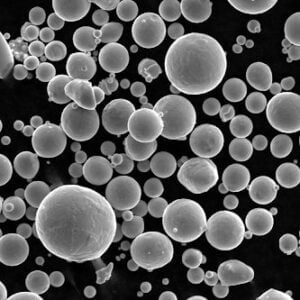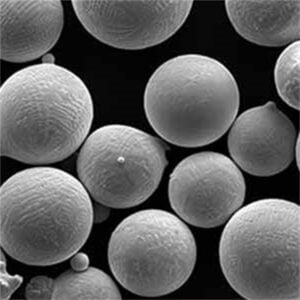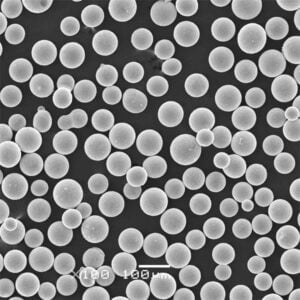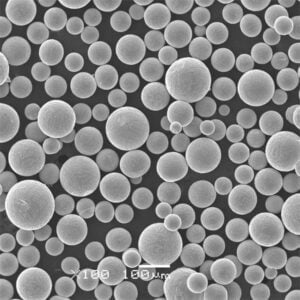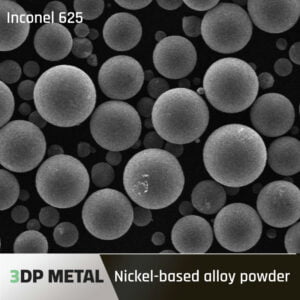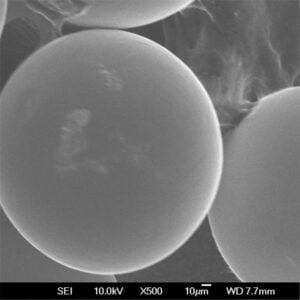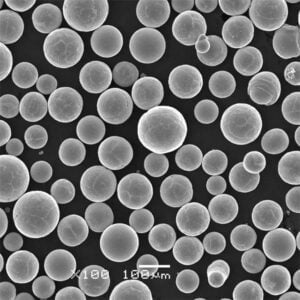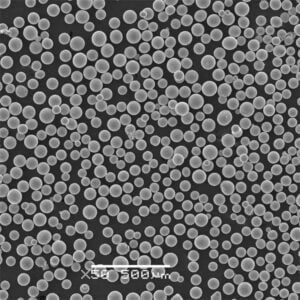3D tisk Inconel
Obsah
Inconel označuje skupinu superslitin na bázi niklu a chromu, které jsou známé svou odolností vůči teplu, korozi a tlaku. 3D tisk materiálu Inconel přináší větší volnost při navrhování a lepší mechanické vlastnosti ve srovnání s konvenčními výrobními postupy v odvětvích, jako je letectví, energetika a automobilový průmysl.
Přehled 3d tisk inconel
Superslitiny Inconelu jsou nikl-chromové materiály zesílené přídavkem železa, niobu, molybdenu a dalších prvků. Díky své pozoruhodné teplotní, korozní a únavové odolnosti je Inconel vhodný pro náročné aplikace.
3D tisk pomocí techniky tavení v práškovém loži nabízí nový potenciál pro výrobu složitých dílů Inconel s jemnějšími zrny a vyšší pevností ve srovnání s tradičními metodami. Mezi hlavní výhody patří:
- Výroba složitých, lehkých geometrií
- Zlepšené chování v tahu a únavě
- Vyšší přesnost a flexibilita designu
- Kratší dodací lhůty a nižší objemy
- Možnost vytvářet optimalizované mřížové struktury
- Spojení různorodých materiálů do jednoho dílu
Navzdory výhodám je třeba pro kvalitní tištěné součásti z Inconelu řešit problémy, jako je zbytkové napětí, riziko pórovitosti a následné zpracování.
Celkově lze říci, že aditivní výroba otevírá inovativní aplikace Inconelu v oblasti tepelných výměníků, spalovacího hardwaru, leteckých komponentů, biomedicínských implantátů a dalších oblastí vyžadujících extrémní odolnost vůči okolnímu prostředí.
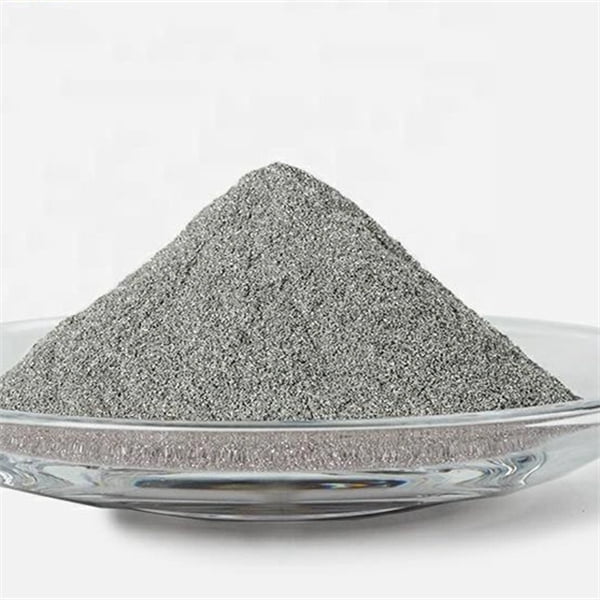
Složení 3d tisk inconel
Inconel je široká značka superslitin, která označuje více než dvě desítky materiálů na bázi precipitačně tvrzeného niklu určených pro náročné aplikace v oblasti tepla, koroze a tlaku.
Vysoký obsah niklu v nich vytváří austenitickou krystalovou strukturu FCC, která zajišťuje zpevnění v pevném roztoku. Přidané prvky, jako je chrom, železo, niob, molybden, hliník a titan, usnadňují precipitační kalení a zlepšují mechanické vlastnosti.
Typické rozmezí složení:
| Živel | Složení (hmotnost %) |
|---|---|
| nikl (Ni) | 50-80% |
| Chrom (Cr) | 10-25% |
| železo (Fe) | 0-50% |
| niob (Nb) | 0-5% |
| molybden (Mo) | 0-9% |
| hliník (Al) | 0-6% |
| Kobalt (Co) | 0-2% |
| titan (Ti) | 0-5% |
| Wolfram (W) | 0-7% |
| uhlík (C) | 0-0.2% |
Specifické třídy Inconelu mají užší rozsahy legování zaměřené na specifické aplikace. Například:
Inconel 625
- 58% Ni
- 20-23% Cr
- 8-10% Mo
- 3-4% Nb
- 0-5% Fe
Inconel 718
- 50-55% Ni
- 17-21% Cr
- 4.75-5.5% Nb
- 2,8-3,3% Mo
- 0-1% Al
Vliv hlavních legujících prvků:
- Nikl - dominantní prvek zajišťující odolnost proti korozi a tažnost
- Chrom - odolnost proti oxidaci a tvrdost za vzniku oxidů Cr
- Niob - Karbidový prvek rozhodující pro zpevnění srážek
- Molybden - zpevňovač pevného roztoku
- Železo - přispívá ke zpevnění pevného roztoku
- Hliník + titan - Tvorba gama precipitátů pro výrazné zpevnění slitin
3d tisk inconel Vlastnosti
Materiály Inconel nabízejí výjimečnou kombinaci tepelné odolnosti, korozní odolnosti, vysoké pevnosti a vynikající únavové životnosti, která výrazně převyšuje standardní nerezové oceli. Díky tomu jsou vhodné pro extrémní požadavky i přes vyšší cenu.
Fyzikální vlastnosti
- Hustota - Rozsah 7,9-8,5 g/cm3
- Bod tání - 1300-1450 °C v závislosti na přesném složení
- Elektrický odpor - Rozsah 70-94 μΩ-cm
- Tepelná vodivost - Slabší při 10-20 W/m-K
- Koeficient tepelné roztažnosti - Přibližně 13-16 (μm/m)/°C
Mechanické vlastnosti
- Pevnost v tahu - 500-1500 MPa
- Pevnost v tahu - 240-1200 MPa
- Prodloužení – 10-55%
- Tvrdost - Rockwell B 80-150
- Modul pružnosti - 150-210 GPa
- Lomová houževnatost - 100-300 MPa-m^1/2^
Výkonnostní limity
- Maximální provozní teplota - 650-1100°C
- Odolnost proti oxidaci - Až 900-1100 °C na vzduchu
- Odolnost proti vodní korozi - Široká škála médií
- Odolnost proti sulfidaci - Kontinuální 500-900 °C
Únavová pevnost
Hlavní výhodou Inconelu je vynikající únavová odolnost, která se zachovává i při tepelném a mechanickém namáhání. Například Inconel 718 nabízí působivou životnost při přetržení více než 100 000 hodin při teplotách blížících se 700 °C.
Metody aditivní výroby
Inconel lze vytisknout 3D tiskem pomocí techniky fúze v práškovém loži, kdy laser nebo elektronový paprsek spojuje postupné vrstvy kovového prášku na základě digitálních modelových řezů. To umožňuje tisknout složité geometrie Inconelu, které nelze dosáhnout subtraktivními metodami.
Dvěma převládajícími používanými technologiemi jsou:
Laserová fúze v práškovém loži (L-PBF)
Známé také jako přímé laserové spékání kovů (DMLS), při němž vysoce výkonný laser skenuje práškové lože a selektivně taví oblasti odpovídající průřezu dílu, přičemž po rychlém ztuhnutí dochází ke spojení částic.
Fúze v práškovém loži s elektronovým svazkem (E-PBF)
Elektronový paprsek je zdrojem energie o vysoké hustotě, která slouží ke spojování vrstev prášku na základě geometrie modelu CAD. Prostředí pro sestavování je ve vakuu, což eliminuje problémy s rozptylem paprsku.
L-PBF je dostupnější a rychlejší, zatímco E-PBF dokáže lépe zpracovávat vysoce reflexní materiály, jako jsou slitiny hliníku nebo mědi. Obě metody umožňují míchání slitin v rámci jedné tištěné součásti.
Úvahy o procesu
Mezi výzvy, které jsou specifické pro Inconel AM, patří vysoká tepelná napětí vedoucí k praskání a deformaci, vnitřní zbytková napětí omezující geometrii, drsnost při tisku vyžadující dokončovací úpravy, složitost vývoje parametrů ve srovnání s ocelí a nedostatek konstrukčních údajů.
K dosažení cílového mechanického výkonu je třeba pečlivě optimalizovat strategii skenování, teplotu, výkon paprsku, rozteč šraf, vlastnosti prášku, tepelný management a následné zpracování.
3d tisk inconel Tisknutelné známky
Nejběžnějšími variantami Inconelu jsou Inconel 625 a Inconel 718, které představují více než 75% použití, dále Inconel 800, Inconel 686 a speciální třídy pro specifické aplikace.
Inconel 625
Tato pracovní slitina niklu, chromu a molybdenu nabízí pevnost s vynikající pájecí schopností a korozní odolností i při extrémních teplotách až 980 °C. Používá se pro spalovací plechovky, ventily motorů, výměníky tepla a zařízení pro chemické zpracování.
Inconel 718
Niklová ocel pro letecký průmysl s výjimečnou mezí kluzu až 1 200 MPa a schopností zachovat si vlastnosti při dlouhodobém používání při teplotě 650 °C. Díky vysoké pevnosti, houževnatosti a odolnosti proti únavě je tato ocel zlatým standardem pro letecký hardware, jako jsou lopatky a disky turbín.
Inconel 800
Slitina železa, niklu a chromu zajišťující výjimečnou odolnost vůči nauhličování a oxidaci v prostředí do 1150 °C. Používá se v přehřívacích trubkách, zařízeních pro tepelné zpracování, ohřívačích atd.
Inconel 686
Modifikace Inconelu 625 navržená pro zlepšení mezikrystalové koroze a důlkové koroze pomocí přídavku wolframu a molybdenu. Používá se v systémech odsíření spalin a v jaderných parogenerátorech.
Vlastní stupně
Výzkum a vývoj pro vysoce hodnotné aplikace mísí Inconel s karbidy, slitinami s vysokou entropií nebo jinými částicemi, aby se dále zvýšily vlastnosti, jako je odolnost proti tečení, únavě, otěru nebo korozi.
3d tisk inconel Mechanický výkon
Obecně lze říci, že aditivně vyráběný Inconel vykazuje lepší chování v tahu a únavě ve srovnání se svými odlévanými nebo tepanými protějšky.
Například Inconel 718 vytištěný 3D tiskem vykazuje o více než 30% vyšší pevnost v tahu a mez kluzu ve srovnání s konvenčně zpracovaným materiálem, přičemž si stále zachovává znatelnou tažnost nad 10% prodloužení.
Typické mechanické vlastnosti běžných tištěných tříd Inconelu
| Slitina | Mez pevnosti v tahu (MPa) | Mez kluzu (MPa) | Prodloužení (%) |
|---|---|---|---|
| Inconel 625 | 860-980 | 500-690 | 40-55 |
| Inconel 718 | 1250-1300 | 1050-1160 | 12-25 |
| Inconel 800 | 450-760 | 240-550 | 30-60 |
Zvýšená pevnost je důsledkem výrazného zjemnění zrn až na 5-10 mikronů u tištěného Inconelu (namísto průměrné velikosti zrn podle ASTM >50 mikronů u tepaného materiálu). Toto Hall-Petchovo zpevnění v kombinaci s některými zachovanými intermetalickými fázemi vysvětluje lepší mechanické schopnosti.
Mikrostruktury směrově tuhnoucího typu a textury přizpůsobené očekávaným podmínkám zatížení mohou dále zvýšit výkonnost. Na druhou stranu vady, jako je pórovitost nebo praskliny způsobené nevhodnými parametry tisku, mají negativní dopad na vlastnosti.
3d tisk inconel Aplikace
3D tisk rozšiřuje použití materiálu Inconel na výkonově kritičtější aplikace vyžadující složité tvary, rychlou realizaci nebo vlastní slitiny a zároveň doplňuje konvenční subtraktivní techniky pro jednodušší komponenty, které nepřekračují limity materiálu.
Aerospace
Součásti raketového pohonu, lopatky turbín, palivové trysky a spalovací vložky vyrobené aditivním způsobem překonávají tradičně zpracovávané superslitiny při extrémních tepelných tocích a tlacích. Optimalizované chladicí kanály a lehčí konsolidované sestavy se rovněž realizují.
Ropa a plyn
Hardware hlavic vrtů, vrtné nástroje, vrtné korunky a pouzdra těží ze zvýšené odolnosti proti opotřebení a korozi tištěných směrově tuhnoucích součástí z Inconelu s geometrií a integrací vestavěných senzorů, jejichž výroba je jinak náročná.
Výroba elektřiny
Trubky výměníků tepla, spirály přehříváků a součásti horké části plynových turbín mají 2-4násobnou životnost díky složení Inconelu na míru a složitým konformním kanálkům ochlazujícím kritické oblasti.
Automobilový průmysl
Míchání různorodých tříd Inconelu umožňuje, aby jednotlivé hlavy válců integrující funkce výfukového potrubí vydržely teploty přesahující 850 °C, aniž by se roztavily nebo popraskaly, a zároveň optimalizovaly průtoky chladicí kapaliny.
Nové aplikace
Flexibilitu Inconelu AM využívají zejména zakázkové lékařské a zubní implantáty, mikrofluidní reaktory a chladiče, elektrody pro elektrolýzu a specifické úlohy v letectví a kosmonautice.
Globální dodavatelé a ceny
Výrobu tištěných dílů z Inconelu celosvětově podporuje řada smluvních výrobců, tiskáren kovů, tiskařských kanceláří, dodavatelů prášků, softwarových společností a dodavatelů povrchových úprav dílů. Ceny se liší v závislosti na faktorech, jako je objem objednávky, požadavky na tolerance, doba realizace a požadavky na kvalitu.
| Společnost | Umístění sídla |
|---|---|
| Renishaw | Spojené království |
| Přísady GE | NÁS |
| 3D Systems | NÁS |
| EOS | Německo |
| Velo3D | NÁS |
| Přísada pro tesaře | NÁS |
| Protolaby | NÁS |
| Materialise | Belgie |
| Höganäs | Švédsko |
| Aubert & Duval | Francie |
Odhadované náklady na díly:
Rozsah tištěných dílů Inconel je od $50-500 na palec krychlový na základě složitosti, spotřeby spotřebního materiálu, obtížnosti zpracování ve srovnání s běžnými slitinami, jako jsou oceli nebo titan, a požadované kvality povrchové úpravy. Velkoobjemové závazky výrazně zlepšují úspory z rozsahu.
Normy a specifikace
Vývoj parametrů tisku podle existujících norem pro zpracování Inconelu v tvářeném stavu pomáhá sladit složení a základní mechanická očekávání:
| Standard | Organizace | Třídy, na které se vztahuje |
|---|---|---|
| AMS 5662 | SAE | Inconel 625 |
| AMS 5663 | SAE | Inconel 718 |
| AMS 2875 | SAE | Inconel X-750 |
Specifické normy pro AM zahrnující konstrukci, kvalifikaci, testování, certifikaci, manipulaci s práškem a další aspekty pro tištěný Inconel se však stále vyvíjejí:
- ASTM F3055 - Standardní specifikace pro aditivní výrobu niklové slitiny (UNS N06625) s práškovou fúzí
- ASTM F3056 - Standardní specifikace pro aditivní výrobu niklové slitiny (UNS N07718) s práškovou fúzí
- ASME BPVC Section IX - Svařování, pájení a tavení - kvalifikace
- AWS D20.1 - Výroba kovových součástí aditivní výrobou
Použití zavedených kovaných tříd jako vstupní suroviny při současné kontrole variability tiskového procesu podle těchto specifikací zajišťuje konzistentní vlastnosti tištěného Inconelu.
Výhody a nevýhody aditivně vyráběného Inconelu
| Výhody | Nevýhody |
|---|---|
| - Zvýšená pevnost a odolnost | - Vysoké náklady na tiskárny a vstupní materiály |
| - Složité vnitřní prvky, jako jsou mřížky | - Omezená velikost podle obálek tiskárny |
| - Kratší doba výroby | - Nižší výkon ve srovnání s odléváním/kovením |
| - Vlastní slitiny a mikrostruktury | - Často je vyžadováno rozsáhlé následné zpracování |
| - Konformní chladicí kanály | - Anizotropní vlastnosti při nanášení vrstev |
| - Topologicky optimalizované lehké díly | - Rizika zbytkového napětí a deformace |
| - Konsolidace dílů do jednotlivých součástí | - Kvalifikační a certifikační výzvy |
| - Zlepšená flexibilita dodavatelského řetězce | - Některé mechanické vlastnosti snížené oproti tepané |
| - Zkrácení dodacích lhůt a skladových zásob | - Opatření pro manipulaci se sypkým práškem |
| - Svoboda návrhu nad rámec subtraktivních metod |
Obecně lze říci, že optimální způsoby výroby dílů z Inconelu se určují na základě porovnání možností tiskárny s požadavky aplikace a náklady.
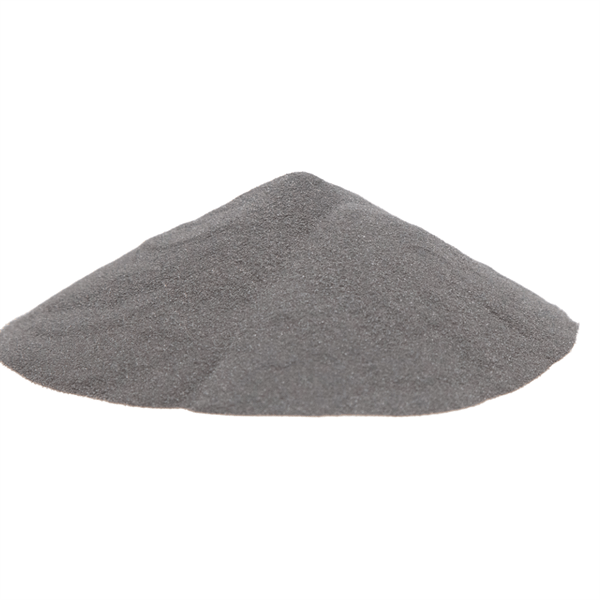
FAQ
Otázka: Jaké jsou osvědčené postupy pro zlepšení kvality 3D tištěných dílů Inconel?
Odpověď: Optimalizace parametrů, správa prášku, variace strategie skenování, tepelné cykly na míru, HIP a tepelné úpravy, povrchová úprava, CT skenování a komplexní mechanické validační testování - to vše pomáhá překonat problémy aditivního procesu a zajišťuje spolehlivou integritu tištěného Inconelu po celou dobu jeho životnosti.
Otázka: Který tiskový proces produkuje lepší díly z Inconelu - laserový nebo elektronový svazek s práškovým ložem?
Odpověď: Obě metody umožňují vyrábět součásti z Inconelu s plnou hustotou, ale laser lépe zvládá povrchovou úpravu, zatímco elektronový paprsek umožňuje vyrábět součásti s vyšším poměrem stran, i když při nižších rychlostech. Výkon závisí také na konkrétních možnostech zařízení, jako je výkon paprsku, velikost skvrny, dráha rastru, velikost komory a přesnost.
Otázka: Jaká je únavová životnost tištěného Inconelu ve srovnání s tradičně vyráběnými součástmi?
Odpověď: Za podmínek vysokocyklové únavy aditivně vyráběný Inconel obecně splňuje nebo překonává vlastnosti litých a tepaných slitin. Například Inconel 718 vykazuje 6-8x delší životnost než odlitky. Při komplexní tepelně-mechanické únavě však vady kontrolují selhání, což umožňuje buď kratší, nebo delší životnost v závislosti na úrovni optimalizace ve srovnání s jinými procesy.
Otázka: Lze 3D tisknout vlastní slitiny Inconelu i mimo běžné třídy jako 625 a 718?
Odpověď: Ano, výzkum a vývoj často vyvíjí speciální práškové směsi, které zvyšují vlastnosti, jako je tuhost, pevnost, tažnost, odolnost proti opotřebení, chování při vysokých teplotách a odolnost proti korozi, a to prostřednictvím řízených přídavků prvků, jako je wolfram, tantal, kobalt, hliník, uhlík a další, v rámci parametrů rodiny Inconel.
Otázka: Jaký vývoj povede k dalšímu nárůstu využití aditivně vyráběných komponent Inconel?
Odpověď: Rychlejší zařízení snižující výrobní náklady, hybridní výroba kombinující AM se subtraktivními technikami v jednom systému, pokročilé monitorování procesu a uzavřená kontrola pro minimalizaci vad, rozšířené možnosti slitin, úplnější konstrukční údaje a přísné kvalifikační normy specificky zaměřené na tištěný Inconel - to vše rozšíří možnosti použití.
Sdílet na
MET3DP Technology Co., LTD je předním poskytovatelem řešení aditivní výroby se sídlem v Qingdao v Číně. Naše společnost se specializuje na zařízení pro 3D tisk a vysoce výkonné kovové prášky pro průmyslové aplikace.
Dotaz k získání nejlepší ceny a přizpůsobeného řešení pro vaše podnikání!
Související články

Vysoce výkonné segmenty lopatek trysek: Revoluce v účinnosti turbín díky 3D tisku z kovu
Přečtěte si více "O Met3DP
Nedávná aktualizace
Náš produkt
KONTAKTUJTE NÁS
Nějaké otázky? Pošlete nám zprávu hned teď! Po obdržení vaší zprávy obsloužíme vaši žádost s celým týmem.

Kovové prášky pro 3D tisk a aditivní výrobu
SPOLEČNOST
PRODUKT
kontaktní informace
- Město Qingdao, Shandong, Čína
- [email protected]
- [email protected]
- +86 19116340731






